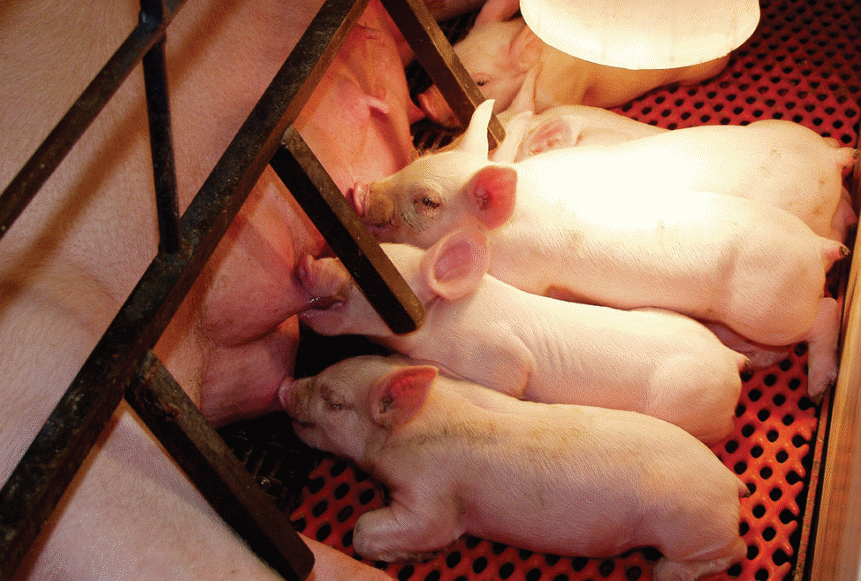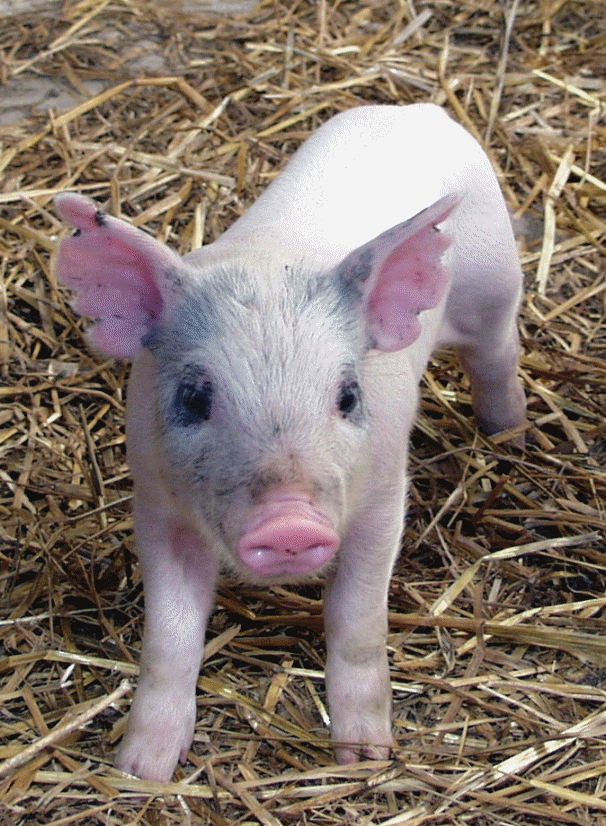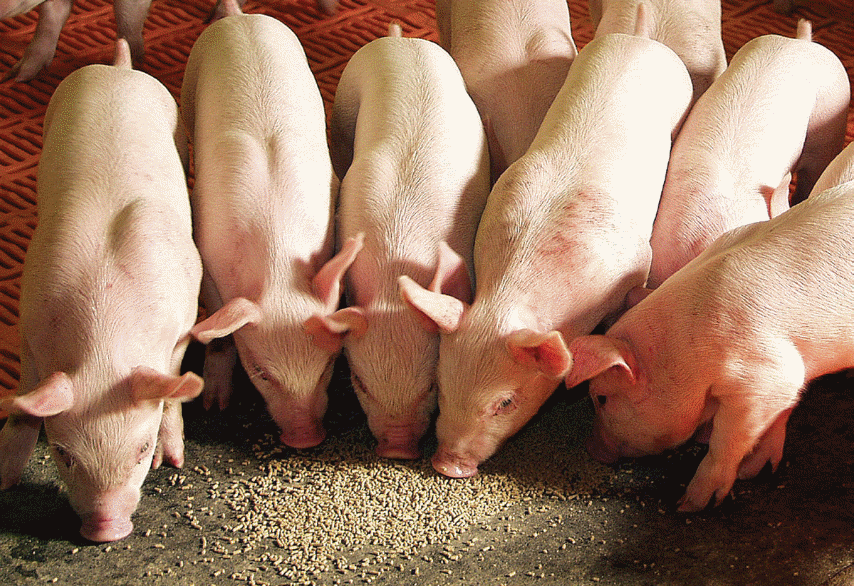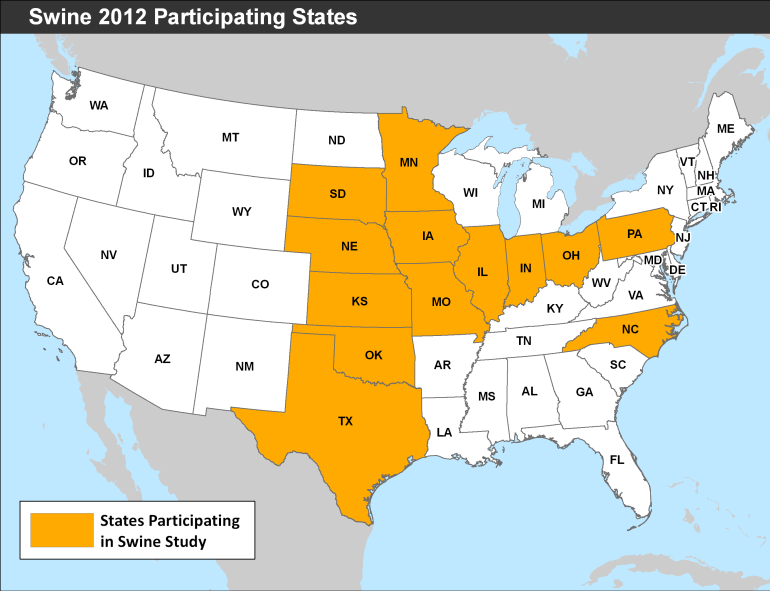NAHMS Swine 2012 Study Brochure
Brochure.docx
Swine 2012 Study
NAHMS Swine 2012 Study Brochure
OMB: 0579-0315
November
2011


NAHMS Swine 2012 Study
In June 2012, the USDA’s National Animal Health
Monitoring System (NAHMS), in collaboration with the
National
Agricultural Statistics Service (NASS), will begin the Swine 2012
study. This national study will take an
in-depth look at swine
operations in the United States and provide the industry with an
update of information last collected during the NAHMS Swine 2006
study.
Study focus
NAHMS worked with an array of stakeholders to define the most critical information gaps to be addressed in the upcoming study. Six study objectives were identified:
Describe current U.S. swine production practices including general management practices, housing practices, productivity, disease prevention, and mortality for five phases of production: gestation, farrowing, nursery, grow/finish, and wean-to-finish;
Describe trends in swine health and management practices;
Determine the prevalence and associated risk factors for select respiratory, neurologic, gastrointestinal, systemic, and foodborne pathogens found in weaned market hogs;
Describe antibiotic usage patterns in weaned market hogs to control and treat disease and promote growth;
Evaluate presence of or exposure to select pathogens and characterize isolated organisms from the collection of biological specimens (feces, sera, saliva); and
Update estimates of the economic cost of select respiratory, neurologic, gastrointestinal, systemic, and foodborne pathogens found in commercial swine herds and create estimates of the economic cost of different treatment approaches.

Study
activities for participants
(operations
with 100 or more hogs)
Participants on operations with an inventory of 100 or more head in 13 States (IL, IN, IA, KS, MN,
MO, NE, NC, OH, OK, PA, SD, and TX) will be asked to provide important health management and productivity information to characterize the swine industry (see map above). Fecal, blood, and other biological specimens will be collected for analysis on a subset of operations. Data collection will begin in June 2012.
Representatives from NASS will visit a random sample of selected swine operations to complete a questionnaire.
NASS will also mail out a questionnaire to a different random sample and follow up by telephone to assist in completing that questionnaire. Producers have the option to mail back the questionnaire and receive no further contact.
NASS will identify producers interested in the next phase of the NAHMS Swine 2012 study administered by APHIS.
Beginning in September 2012, swine operations will be contacted by APHIS personnel for a followup interview.
Collection of biological specimens on a subset of operations will be conducted. Fecal samples will be evaluated for the presence of enteric bacteria that are considered foodborne pathogens. Blood samples will be tested for evidence of host exposure to selected swine pathogens.
Study
activities for participants
(operations
with fewer than 100 hogs)
Participants on operations with an inventory of fewer than 100 head in 31 States (AL, AR, AZ, CA, CO, FL, GA, HI, IA, IL, IN, KS, LA, MI, MN, MO, MS, NC, NE, NJ, NM, NY, OH, OK, PA, SC, SD, TN, TX, WA, and WI) will also be asked to provide important health management information about their operations. Data collection will begin in June 2012.
NASS will mail out a short questionnaire tailored to smaller operations and follow up by telephone to assist in completing that questionnaire. Producers have the option to mail back the questionnaire and receive no further contact.
Benefits to the U.S. pork industry from the Swine 2012 study
In-depth reports and information sheets will provide a national snapshot of current management, health, and productivity of the U.S. swine herd.
Laboratory test results for biological specimens collected during the study will be returned to participating producers, such as PRRS results for serum collected from sows and finishers or Salmonella results from fecal samples.
Serum aliquots will be added to the serum bank that began in 1990 and made available to address emerging diseases or to elucidate the natural history of endemic diseases.
Objective data on antibiotic usage patterns in weaned market pigs will inform those engaged in the national debate on the use of antibiotics in swine.
Broad geographic representation of the health status of U.S. pigs will be used to facilitate trade and enhance the U.S. position in international markets, such as toxoplasmosis and trichinellosis.
Scientifically valid estimates of productivity will be used to assess the economic impact of PRRS on the swine industry.
National estimates spanning nearly 25 years will help assess changes in swine management, health, and productivity.
Foodborne pathogens isolated on-farm will be characterized, including isolation rates, serotypes, and resistance patterns for enteric pathogens.
A scientific approach
NAHMS collects and reports accurate and useful information on animal health and management in the
United States. Since 1990, NAHMS has developed national estimates on disease prevalence and other factors related to the health of U.S. beef cattle, sheep, goat, dairy cattle, swine, equine, poultry, and catfish populations. The science-based results produced by
NAHMS have proven to be of considerable value to the U.S. livestock, poultry, and aquaculture industries as well as to other animal health stakeholders.
NAHMS studies are
National in scope,
Voluntary
Confidential,
Statistically valid,
Scientific, and
Collaborative.
Confidentiality
Because NAHMS studies rely on voluntary participation, the privacy of every participant is protected. Only those collecting the data know the identity of the respondent. No name or contact information will be associated with individual data, and no data will be reported in a way that could reveal the identity of a participant. Data are presented only in an aggregate manner.
For more information, contact:
USDA–APHIS–VS–CEAH
NRRC Building B, M.S. 2E7
2150 Centre Avenue
Fort Collins, CO 80526-8117
970.494.7000
Email: [email protected]
Or visit NAHMS at
http://nahms.aphis.usda.gov
#634.1111
____________________________________
The U.S. Department of Agriculture (USDA) prohibits discrimination in all its programs and activities on the basis of race, color, national origin, age, disability, and where applicable, sex, marital status, familial
status, parental status, religion, sexual orientation, genetic information, political beliefs, reprisal, or because all or part of an individual’s income is derived from any public assistance program. (Not all prohibited
bases apply to all programs.) Persons with disabilities who require alternative means for communication of program information (Braille, large print, audiotape, etc.) should contact USDA’s TARGET Center at (202) 720–2600 (voice and TDD). To file a complaint of discrimination, write to USDA, Director, Office of Civil Rights, 1400 Independence Avenue, S.W., Washington, D.C. 20250–9410, or call (800) 795–3272 (voice) or (202) 720–6382 (TDD). USDA is an equal opportunity
provider and employer.
Photographs courtesy The National Pork Board

![]()
![]()
| File Type | application/vnd.openxmlformats-officedocument.wordprocessingml.document |
| Author | chaley |
| File Modified | 0000-00-00 |
| File Created | 2021-02-01 |
© 2026 OMB.report | Privacy Policy